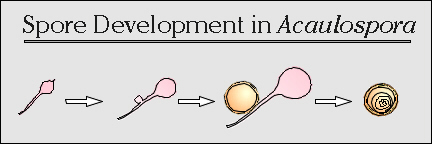Acaulospora Gerd. & Trappe emend. Berch
| Term | Description |
|---|---|
| Etymology: | Greek, “spores without a stem” or sessile spores |
| Description: | This genus originally was defined by spores borne laterally from the neck of a pre-differentiated “sporiferous saccule.” However, species previously in Entrophospora which show genetic relatedness to Acaulospora species are included in this genus because the “entrophosporoid” spore phenotype is a convergent trait (arose in clades with different common ancestors) |
| Type species: | A. laevis Gerd. & Trappe |
Spore Ontogeny
The sporiferous saccule develops blastically from a hyphal tip. After the saccule has become fully expanded, a spore begins to develop from the side of the subtending hypha (termed "saccule neck"). As the spore matures, the saccule loses its contents (it does not empty into the spore) and eventually sloughs off so that it often is not attached to fully mature spores.

The distinction between Acaulospora and its sister genus, Entrophospora, lies exclusively in the positioning of the spore as it develops from the saccule neck. In reality, this trait has evolved multiple times and cannot define a unique monophyletic clade because the trait is the product of convergent evolution. In phylogenetic terminology, placing all species within spores inside the neck of the saccule in one genus (Entrophospora) indicates the group is "paraphyletic." We recognized this just from morphological relationships many years ago. rDNA genes (SSU, LSU) clearly place E. colombiana, E. kentinensis, and a new entrophosporoid species in the Acaulospora clade (Kaonongbua et al. 2010) and Entrophospora schenckii in the Archaeospora clade (Schüßler and Walker, 2010).
Literature Cited
- Berch, S.M. 1985. Acaulospora sporocarpia, a new sporocarpic species, and emendation of the genus Acaulospora (Endogonaceae, Zygomycotina). Mycotaxon 23: 409-418.
- Gerdemann, J.W. and Trappe, J.M. 1974. The Endogonaceae in the Pacific Northwest. Mycol. Memoir 5: 1-76.